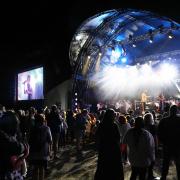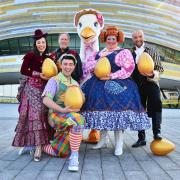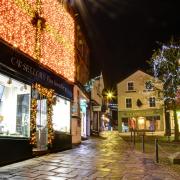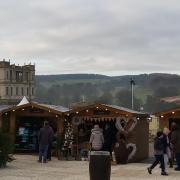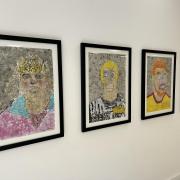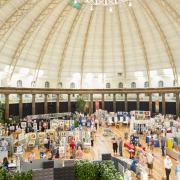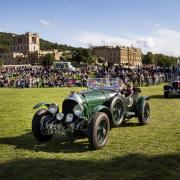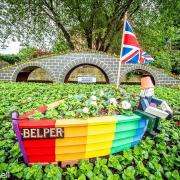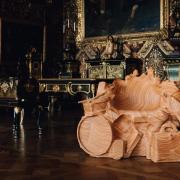Robert Innes-Smith visits Tong in Shropshire and chances upon a church with Derbyshire connections

Derbyshire is lucky in its distinguished great dynasties, one of which is the Vernon family, members of whom still have connections with the county. Although they no longer live at Sudbury Hall they still have much of the land, the late Lord Vernon’s daughter and her family live on the estate close to the Hall, and Haddon Hall is still the home of descendants of the Vernons.
Most people in Derbyshire know of the romantic story of Dorothy Vernon, the heiress of Haddon Hall who, it is said, romantically eloped with Sir John Manners, second son of the 1st Earl of Rutland, and her descendants have owned Haddon ever since. Visitors to Tong will discover another dramatic Vernon link.
Passing along the busy A41 and close to the M54 motorway in Shropshire, near the Staffordshire border the landmark octagonal tower and spire of a large church can be seen. It appears to stand on its own and most people hurry by. If anyone cares to stop and explore they will be in for a great treat. Although Tong Castle, designed by ‘Capability’ Brown in sumptuous bizarre Moorish gothick, is no more there is still a charming village with the ruins of Tong College Hospital. But it is the spectacular perpendicular church of St Bartholomew which beckons. Nikolaus Pevsner wrote ‘The interior can scarcely be taken in.’ Its grand architecture and many wonderful tombs make this a very special place.
The first church was re-built in 1410 by Lady de Pembrugge, widow of Sir Fulke, although relics of the earlier building survive. As you walk in you are surrounded by a bewildering forest of effigies, many in Derbyshire alabaster. Sir Fulke and his lady are commemorated by a plain monument showing the knight in full armour – his head rests on his crested helm, his feet on a lion. Lady de Pembrugge wears a crowned collar, a symbol of her attachment to the Court of King Richard II.
After Sir Fulke’s death the estate was inherited by his great-nephew, Sir Richard Vernon, who was an MP and Speaker of the House of Commons. He married Benedicta Ludlow and they too are commemorated in Derbyshire alabaster, he in plate armour, she memorable because of the intricate carving of the bottom of her dress. This monument has been described as ‘perhaps the finest and most imposing of all the alabaster knights that have come down to us’.
Sir Richard’s Son Sir William Vernon (d.1467) married Margaret Swynfen and they are shown on a fine tomb chest as brasses with the Vernon heraldic fret prominently displayed.
The fret is also seen on the side of the tomb chest of Sir William’s son Sir Henry who was born in 1441. He was Governor and Treasurer to Arthur Prince of Wales the older brother of Henry VIII and first husband of Katherine of Aragon. He christened his youngest son Arthur. Beside him lies his wife – Lady Anne Talbot, daughter of the 2nd Earl of Shrewsbury. Her robes still retain much of their original colouring. Sir Henry built the Chapel of the Salutation of Our Lady known as The Golden Chapel with its fan-vaulted ceiling and his monument fits into a beautifully carved ogee archway. There are two memorials to Arthur Vernon in the Chapel.
The next generation is represented by Richard Vernon of Haddon Hall who died in 1517 and his wife Margaret Dymoke, a scion of the family of Dymoke of Scrivelsby, Lincolnshire – hereditary Champions and Standard Bearers to the Sovereigns of England. The son of this marriage, Sir George Vernon of Haddon Hall, was known as ‘The King of the Peak’ because of his extensive estates in Shropshire and Derbyshire. He married Margaret, daughter of Sir Ralph Longford of Longford, Derbyshire and at his death the male line of this branch of the Vernons died out.
Sir George Vernon left two daughters, the younger, Dorothy married Sir John Manners, mentioned above, thus bringing Haddon into that family which still owns it. The elder, Margaret, married the Hon. Thomas Stanley, 2nd son or the 3rd Earl of Derby thus bringing the Tong Castle estate into the Stanley family. Their massive monument rather dominates the church. The pair lie on a platform supported by eight marble columns. Below, at ground level, is an effigy of their son Sir Edward Stanley who died in 1632. It was he who sold the Tong estate to Sir Thomas Harries thus breaking a long tradition. There is one other Vernon brass to Sir Humphrey and his wife Alice. On the Stanley monument is a recitation of some of their descendants including Lady Venetia Digby (nee Stanley, wife of Sir Kenelm), who was born at Tong Castle and was a celebrated beauty. Ben Jonson wrote an elegy to her and she was painted by Van Dyck.
There is so much more to be said about this fascinating and beautiful church but we can end by mentioning two interesting literary connections. The words at each end of the Stanley monument are said to have been written by Shakespeare. Oxfordians, rightly or wrongly, might attribute authorship to the 17th Earl of Oxford (one of the contenders to authorship of Shakespeare’s work) whose daughter married the 6th Earl of Derby. An interesting talking point.
Oscar Wilde said that one could not read about the death of ‘Little Nell’ without laughing. Outside the South door is a grave marked ‘The reputed grave of Little Nell’. Dickens set the last chapters of The Old Curiosity Shop in Tong but, according to the guidebook, a former verger made it up but also made a bit on the side in tips from visitors to whom he showed the fictitious ‘grave’!
Truly Tong Church is a little-known Midlands masterpiece.
The Church is open daily for visitors. Guided visits ‘Tong Tours’ with an experienced guide and lunch. www.discoveringtong.org






